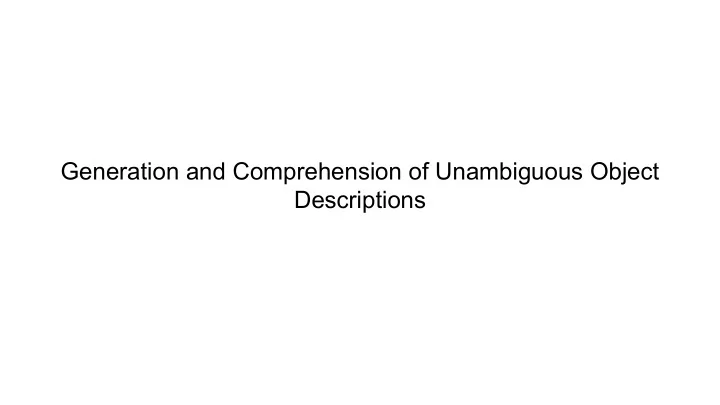

Generation and Comprehension of Unambiguous Object Descriptions
Goal ● Image captioning is subjective and ill-posed - many valid ways to describe any given image, making evaluation difficult ● Referring expression - An unambiguous text description that applies to exactly one object or region in the image. Image caption Referring expression A man playing soccer The goalie wearing an orange and black shirt
Goal Good referring expression - ● Uniquely describes the relevant region or object within its context ● A listener can comprehend and then recover the location of the described object/region Consider two problems - 1) Description generation 2) Description comprehension
Dataset construction For each image in MS-COCO dataset, an object is selected if ● There are between 2 and 4 instances of the same object type in the image ● Objects’ bounding boxes occupy at least 5% of image area Descriptions were generated and verified using MechTurk. Dataset denoted as Google Refexp (G-Ref)
Tasks ● Generation - Given image I, a target region R (through bounding box), generate referring expression S* such that S* = argmax S p(S|R, I) where S is a sentence. Used beam search of size 3 ● Comprehension - Generate set C of region proposals and select region R* = argmax R � C p(R|S, I) Assuming uniform prior for p(R|I), R* = argmax R � C p(S|R, I) At test time, generate proposals using multibox method, classify each proposal into one of the MS-COCO categories and discard those with low scores to get set C .
Baseline Similar to image captioning models. To train the baseline model, minimize Model architecture - ● Use last 1000-d layer of pretrained VGGNet to represent the image and the region. ● Additional 5-d feature [x tl /W, y tl /H, x br /W, y br /H, s bbox /s image ] to encode relative size and location of the the region. x tl , y tl , x br , y br - top-left and bottom right coordinates of the bounding box, s - area, H,W - height and width of the image ● This 2005-d vector is given as input at every time step to an LSTM along with a 1024-d word embedding of the word at previous time step.
Proposed method The baseline method generates expressions based only on the target object (and some context) but does not provide any incentive to generate discriminative sentences. Discriminative (MMI) training Equivalent to maximizing Minimize, mutual information R n - ground truth region, R’ - any region. This method is called MMI - SoftMax
Proposed approach Intuition - Penalize the model if the generated expression could also be plausible for some other region in the same image Selecting proposal set C during training ● Easy ground truth negatives - All ground truth bounding boxes in the image ● Hard ground truth negatives - Ground truth bounding boxes belonging to the same class as target ● Hard multibox negatives - Multibox proposals with same predicted object labels as target Tied weights 5 random negatives for each target Tied weights
Proposed approach MMI-Max Margin ● For computational reasons, use the max margin formulation above ● Has similar effect - penalty if difference between log probabilities of ground truth and negative regions is smaller than M ● Requires comparison between only two images (GT + one negative), thereby allowing larger batch sizes and more stable gradients.
Results Using GT or multibox proposals at test time Ground truth sentence (comprehension task) Generated ● Proposed approaches perform better sentence (generation task) ● Maximum margin performs better than SoftMax ● Better to train using multibox negatives when testing on multibox proposals ● Comprehension easier when using generated sentences than ground truth sentences. Intuitively, a model can ‘communicate’ better with itself using its own language than with others
Results ● Previous results were on the UNC-Ref-Val dataset, which was used to select the best hyperparameter settings for all methods. ● Results of MMI-MM-multibox-neg (full model) on other datasets are also better than baseline ● Human evaluation - % descriptions evaluated as better or equal to human captions Baseline - 15.9% Proposed - 20.4%
Qualitative Results Generation ● Descriptions generated by the baseline and the proposed approach are below and above the dashed line respectively ● Proposed approach often removes ambiguity by providing direction/spatial cues such as left, right, behind
Qualitative Results Comprehension ● Col 1: Test image ● Col 2: Multibox proposals ● Col 3: GT description ● Cols 4-6: Probe sentences ● ● Red bounding box: Output bounding box ● using proposed approach ● Dashed blue bounding boxes (cols 4-6): Other bounding boxes within margin
Semi-supervised training ● D bb+txt - Bounding boxes + text (small set) D bb - Bounding boxes only (large set) ● Learn model G using D bb+txt . Make predictions on D bb to create D bb+auto ● Train an ensemble of different models C on D bb+txt ● Use model C to perform comprehension on D bb+auto . If each ensemble model maps description to the correct object, keep it, else remove it ● Use D bb+text ⋃ D bb+auto to retrain model G and repeat
Results Using GT or multibox proposals at test time Ground truth sentence (comprehension task) Generated sentence (generation task)
Recommend
More recommend